Key takeaways
- Carousel ads are great for engagement. They consistently outperform static formats across platforms by blending storytelling, interactivity, and extra space for rich content. That makes them a smart choice for driving clicks, conversions, and brand connection.
- Strategic design = stronger results. The best carousel ads aren’t just a collection of cards—they tell a story, invite interaction, and align tightly with specific goals. From CTA placement to card sequencing, thoughtful choices make all the difference.
- Test everything (seriously). From the number of cards to copy, CTAs, and even auto-ordering, every element of a carousel ad is a testing opportunity. Lean into experimentation to uncover what resonates best with your audience and makes your budget go further.
Carousel ads combine multiple images and/or videos in a single ad on social media.
Organically, carousels outperform other content types for engagement on almost every platform. Carousel ads give brands the chance to carry that performance through to a paid social strategy.
The carousel ad format is visually engaging and encourages interactivity. It’s also an excellent type for brand storytelling if you use the building blocks of the ad to walk viewers through a product, process, or concept. Perhaps that’s why a recent survey of social media users found that banner or carousel ads were their preferred social ad format.
Benefits of carousel ads across networks
Across platforms, carousel ads are known for higher engagement, click through, and conversion rates than other ad types.
Once users take the time to engage with the ad by swiping through the carousel’s different cards, they’re invested and primed for further interaction. And since they’ve been exposed to more information than they would be in a static social ad, they need less convincing once they have the chance to buy.
For example, Cotton Incorporated ran carousel ads on LinkedIn that drove greater than 1% average CTR and engagement rate, with more than 200 clicks per ad. All of these metrics were improvements over static campaigns on the platform.
Meanwhile, the Soli app ran carousel ads on TikTok and saw a 1.78 times increase in click-through rate, and more than 1000% increase in conversions. They took organic carousels that were already performing well and put budget behind them to expand their audience.
Carousel ad specs and placements
Now that you know why you should think about testing carousel ads, here are the specs you need to develop your ad creative.
Facebook carousel ads
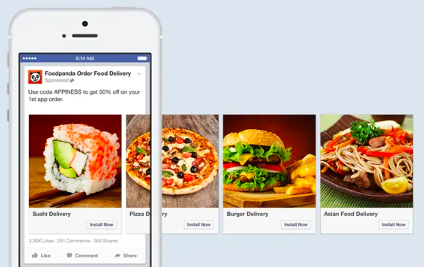
Source: Meta
Placements: Feed, Stories, Reels, Messenger, Right column, Groups feed, In-stream video, Marketplace, search results,
Number of images or videos: 2 to 10 for feed, Reels, and right column; 3 to 10 for Stories (note that videos are not supported in Stories or Reels carousel ads)
Image aspect ratio: 1:1 or 4:5 for feed; 1:1 for Stories and right column; 9:16 for Reels
Image max file size: 30 MB
Image resolution: At least 1080 x 1080
Video max file size: 4 GB
Video duration: 1 second to 240 minutes
Primary text length: 80 characters for feed; 125 characters for Stories; 40 characters for Reels and right column
Headline length: 45 characters for feed; 40 characters for Stories
Description length: 18 characters for feed
Instagram carousel ads
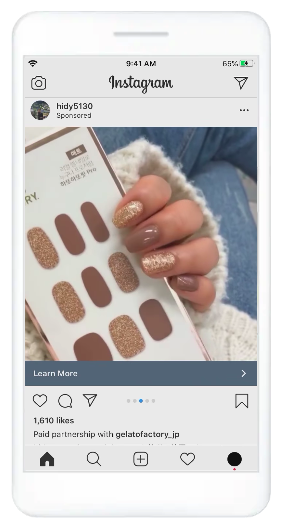
Source: Meta
Placements: Feed, Stories, Reels, Profile feed, Explore,
Number of images or videos: 2 to 10
Image aspect ratio: 1:1 or 4:5 for feed; 9:16 for Stories and Reels
Image max file size: 30 MB
Image resolution: At least 1080 x 1080 for feed and Reels; At least 1080 x 1920 for Stories
Video max file size: 4 GB
Video duration: 1 second to 2 minutes for feed; 1-15 seconds for Stories
Primary text length: 125 characters for feed and Stories
Maximum number of hashtags: 30 in feed
TikTok carousel ads
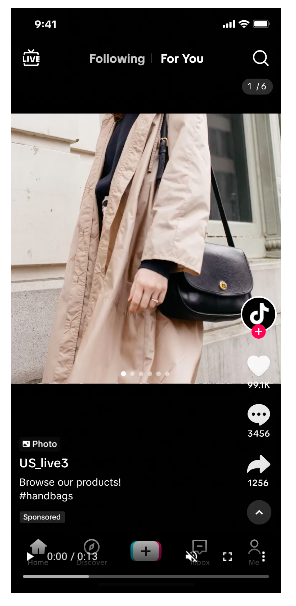
Source: TikTok
Types: Standard carousel ad or Video Shopping Ads (VSA) carousel
Number of images or videos: 2 to 35 for standard, 2 to 20 for VSA
Image max file size: 100 KB
Image resolution: 1200 x 628 pixels or 640 x 620 pixels or 720 x 1280 pixels
Captions: One per carousel for standard; one per image for VSA
LinkedIn carousel ads

Source: LinkedIn
Number of images: 2 to 10 (video not supported)
Image aspect ratio: 1:1
Image max file size: 10 MB
Image resolution: At least 1080 x 1080 pixels
Ad name length: 255 characters
Introductory text length: 255 characters (limit to 150 to avoid truncation on some devices)
Card headline text length: 45 characters
X (formerly Twitter) carousel ads
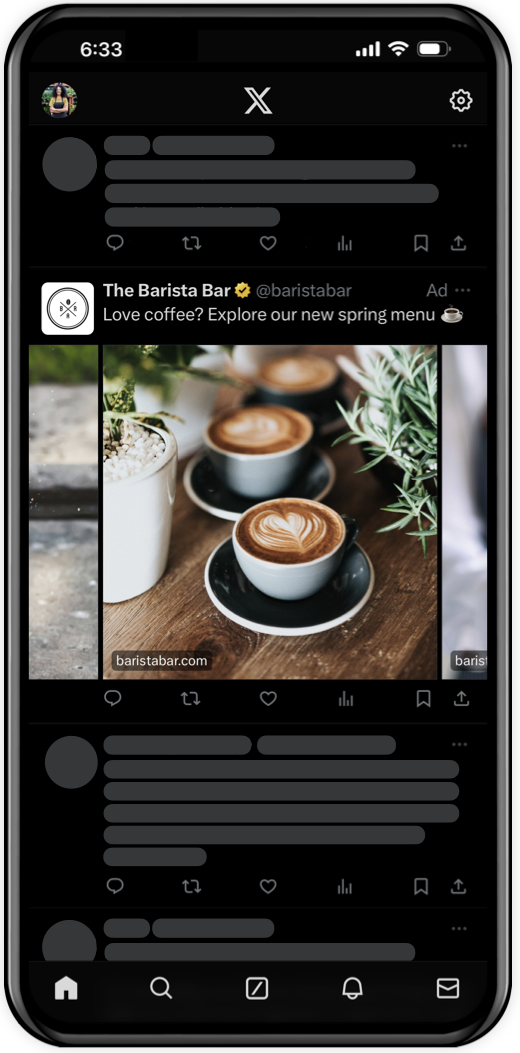
Source: X
Number of images or videos: 2 to 6
Image aspect ratio: 1:1 or 1.91:1
Video ratio: 16:9 or 1:1
Mixed media ratio: 1:1 (if using both images and videos in one carousel)
Image resolution: 800 x 418 or 800 x 800 pixels
Video resolution: 800 x 450 or 800 x 800 pixels
Video duration: Max 140 seconds; under 15 seconds recommended
Title length: 70 characters (truncated after two lines or approx 50 characters)
Pinterest carousel ads
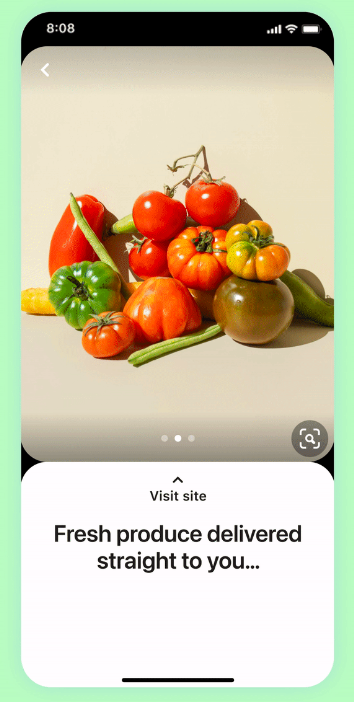
Source: Pinterest Academy
Placements: Home feed, search, related Pins
Number of images: 2 to 5 (video not supported)
Image aspect ratio: 1:1 or 2:3
Image max file size: 20 MB
Title length: 100 characters (limit to 40 to avoid truncation on some devices)
Description length: 500 characters
Snapchat carousel ads

Source: Snapchat
Note: The Story Ad format on Snapchat is similar to carousel ads; the specs below refer to Story Ads.
Placements: In between content, Discover Feed, or automatic between both. The Discover feed placement presents ads most similar to carousel ads on other platforms, where a Story Ad tile opens a collection of images and videos.
Number of images or videos: 1 to 10
Image aspect ratio: 9:16
Image resolution: 1080 x 1920 pixels
Image max file size: 2 MB
Video max length: 180 seconds
Headline maxlength: 34 characters
Tile logo: 993 x 284 pixels
Tile image: 360 x 600 pixels
Tile headline max length: 55 characters
Design best practices that will put your ads to work
You can’t just slap a bunch of images and videos together and call it a day. An effective carousel ad requires strategic design to make it stand out.
Tell a story though mixed formats
“Storytelling should always be the goal when designing carousel ads,” says Paige Schmidt, Hootsuite’s social performance & community marketing specialist.
Schmidt suggests mixing formats to accomplish this goal. “Try combining a beautiful cover image, a video of the product in use, and a testimonial,” she says.
You could also try sharing a sequence of events, providing a step-by-step tutorial, or even creating a series of tips or fun facts that build interest as a user swipes through.
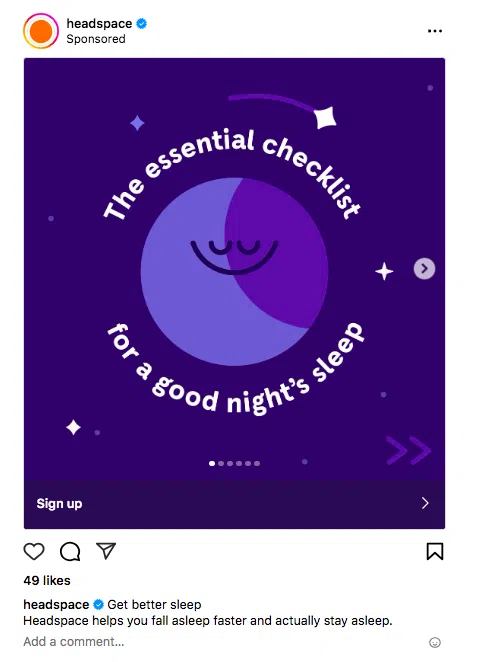
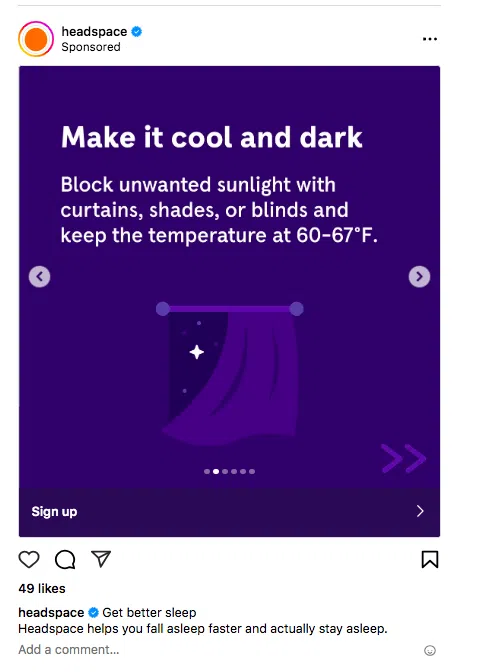
Source: @Headspace
When you choose to tell a story using the carousel format, remember to follow basic storytelling principles by including a clear beginning, middle, and end so it’s easy for your audience to follow along.
Encourage interaction
As we’ve said already, Carousel ads are all about interaction. While this ad format naturally encourages a user to swipe through multiple images and videos, there are opportunities to optimize your carousel ad further for maximum interaction.
Focus on the details for each card. Use the headline, description, and call-to-action (CTA) buttons to encourage people to keep swiping and improve your engagement. Try asking questions, or using prompts to “swipe” or “learn” in your introductory copy.
You could also use your imagery to encourage interaction, like this ad that carries one graphic (and thought) across two cards to encourage the viewer to swipe.
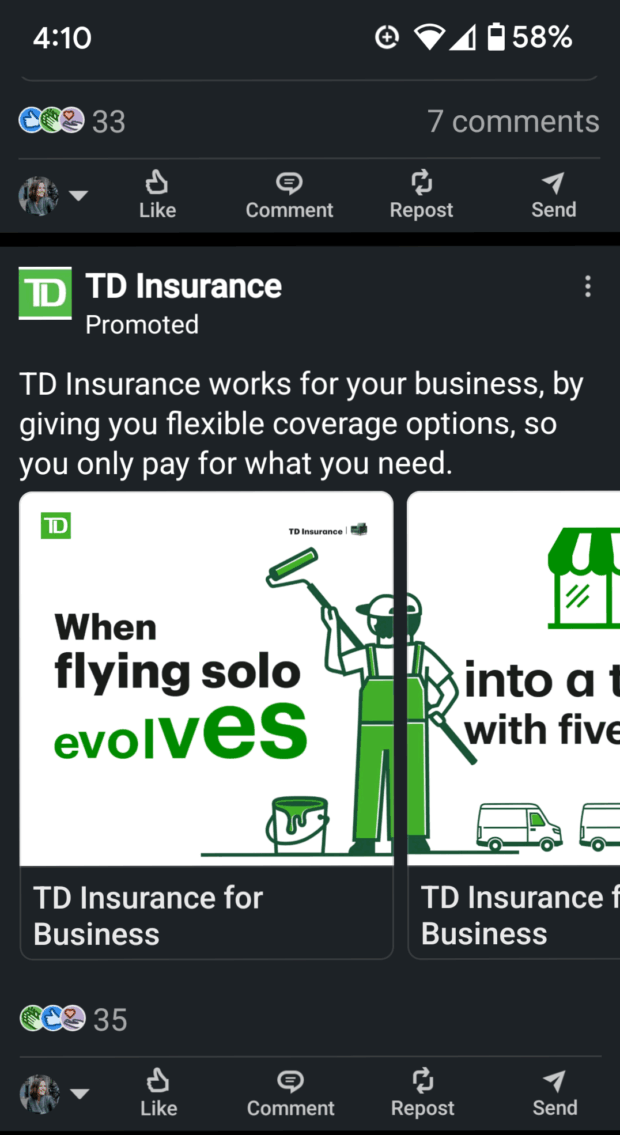
Source: TD Insurance
Make design choices that support your specific business goal
You can use carousel ads to support various campaign objectives – like brand awareness, engagement, click throughs, conversions, and so on. Since carousel ads give you more real estate to work with, you can really tailor your design choices to the specific goal for an individual ad.
For example, if you’re using a carousel ad to support brand awareness goals, you could highlight stories about various members of your team, provide a series of customer testimonials, or walk viewers through a behind-the-scenes process.
This carousel ad from LinkedIn marketing uses multiple carousel cards to walk the audience through the steps of creating a LinkedIn ad campaign.
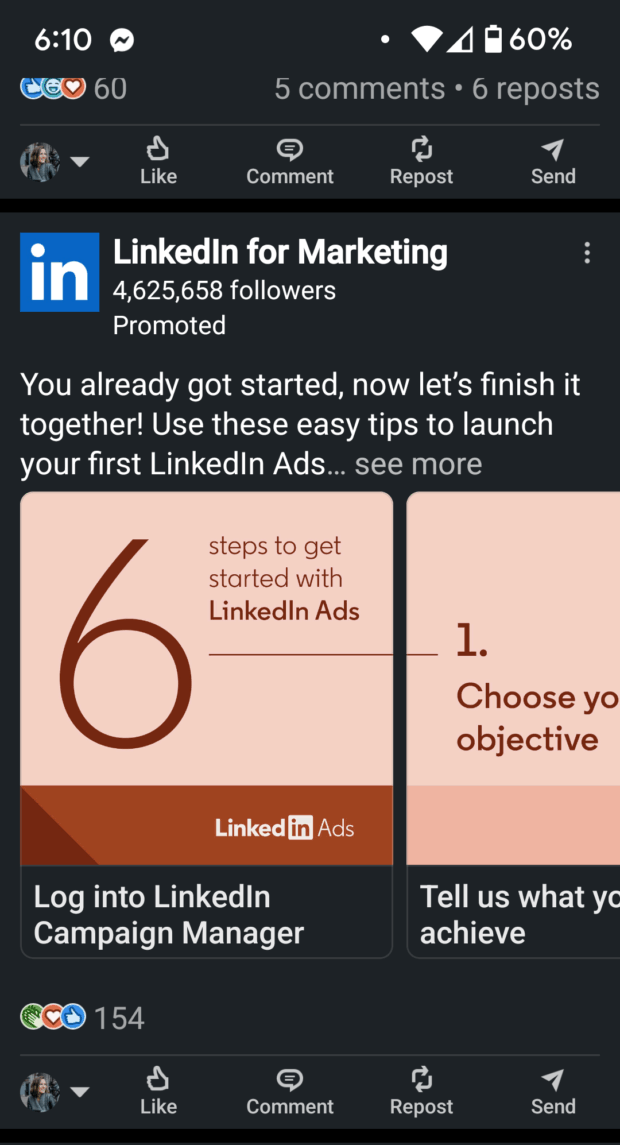
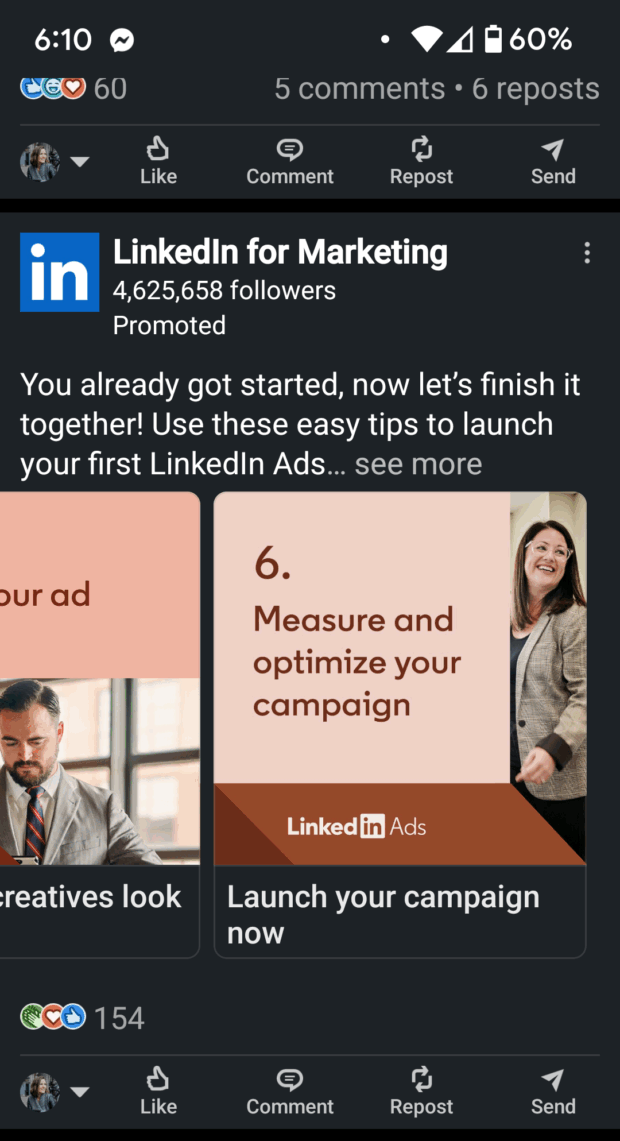
Source: LinkedIn for Marketing
On the other hand, if you’re aiming for viewers to click through to your website or drive conversion goals, you could give them an in-depth look at a single product, service, or product line.
This ad from Tap & Barrel uses the various cards of a carousel ad to highlight multiple features of the restaurant.
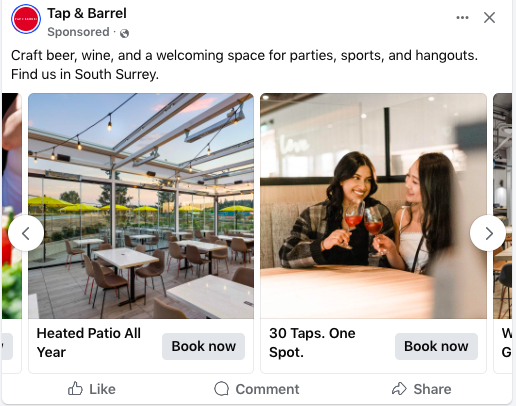
Source: Tap & Barrel
3 A/B tests that will drive better results
Test the number of cards
The maximum number of cards in a carousel ad varies widely across social platforms, from just five all the way up to 35. That gives you a lot of room to test different numbers and combinations of cards. More is not always better! For example, this Mazda ad uses just three cards to show three different perspectives on a vehicle and draw users in.
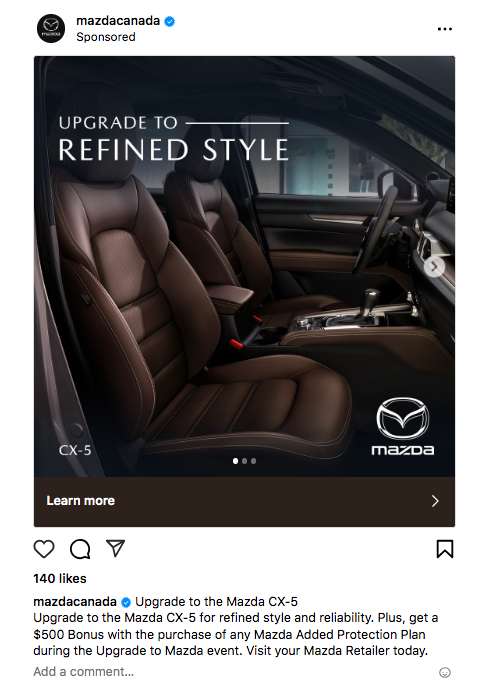
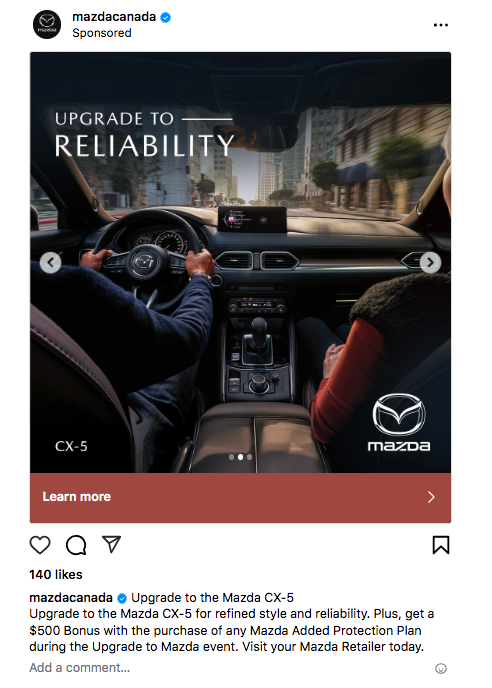
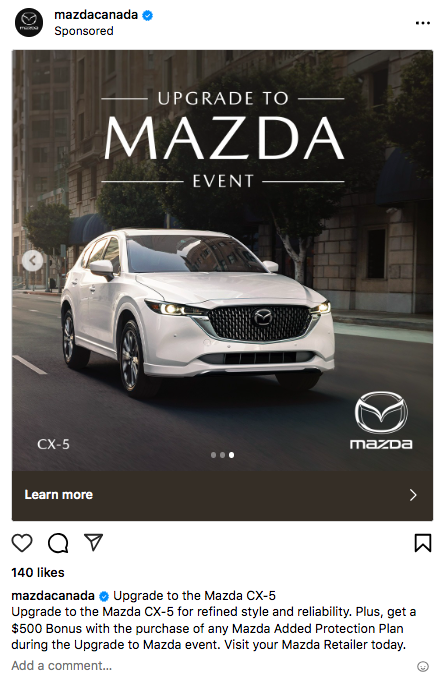
Source: @mazdacanada
You could approach this kind of test in a couple of different ways. First, you could create a carousel with a smaller number of cards so that you can run it across multiple social platforms, testing to see which platform delivers the best results.
Or, you could create different versions of your carousel with more or fewer cards and run them against each other on the same platform to see which resonates better with your target audience.
Remember that a true A/B test only changes one component at a time. That means your carousel ad with fewer cards should draw those cards from the larger carousel rather than having a completely different set of cards. Otherwise you won’t know whether it’s the number of cards or the content of the ad that had the effect.
Test automatic ordering vs controlled ordering
Some of the social platforms allow you to select automatic carousel card ordering. This may be optimized based on the specific user’s preferences, or it may be based on the performance of each card as the ad runs.
If you’re using the carousel ad to showcase various features or any other purpose that does not require a specific ordered structure for narrative purposes, it’s worth testing this automated option to see if it improves your results. However, if your cards only make sense in sequence, be sure to turn this option off!
Facebook also offers the option to convert your carousel cards into a video slideshow on Facebook Feed when its AI predicts that will improve the performance of the ad. Again, this may be a worthwhile test, but be sure not to select this option if you want that detailed narrative arc control.
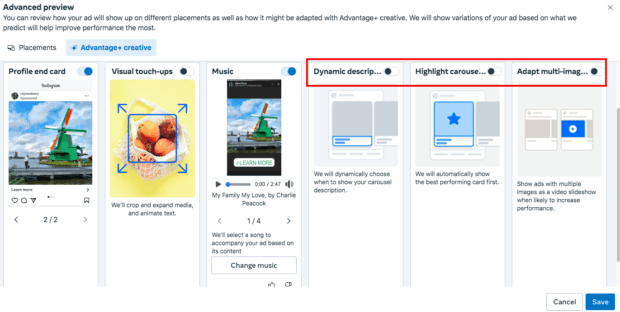
Source: Meta Ads Manager
Test your CTAs, card text, and links
Don’t get so wrapped up in the images and video for your carousel ad that you neglect the copy components. Just like any other ad, you need to test your headlines, the text that supports each card, the link descriptions, and the CTA buttons.
One testing option would be to use similar graphics across the cards with different text, to get a sense of what kind of copy works best to support your goals. This isn’t strictly speaking an A/B test since you’re testing more than one component at a time, but it could still give you some valuable insights.
You could also use a single carousel ad as a test in itself. Create a carousel of different images supported by different copy, to get a sense of which resonates best with your audience. You could then run the winner as a standalone image or video ad.
For example, in this National Geographic Instagram carousel ad, each image is supported by relevant copy and a unique link for the relevant landing page, so the publication could use this as a test to learn which of these stories resonated most with their audience on Instagram.

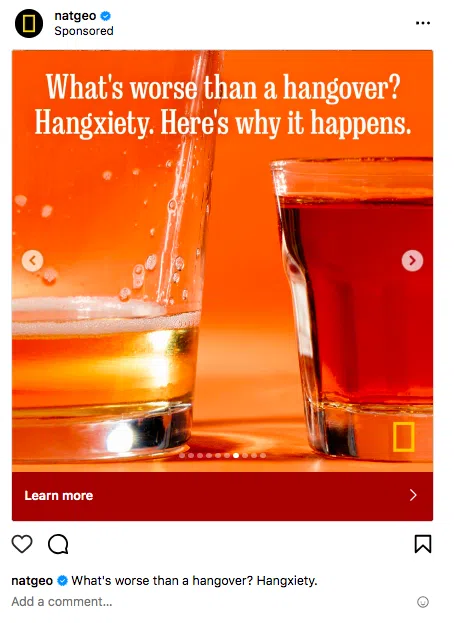
Source: @natgeo
By the way, this is also an example of a carousel ad where the order of cards doesn’t matter, so you could use automatic card optimization. And it’s also an example of an ad that could work well for testing the number of cards. Do viewers get swipe fatigue after too many cards? Or are more stories more likely to catch more people’s interests? Only a test can tell.
Test dynamic catalog carousel ads
So far, this post has focused on carousel ad examples that showcase intentional copy decisions and storytelling components. But carousel ads can also be used to drive ecommerce sales of different products. A catalog carousel ad, available on several social platforms, uses product information from uploaded catalog to create dynamic carousel ads optimized based on user behavior.
For example, I’ve been looking at a lot of Canadian-made clothing lately, so this catalog carousel ad is a natural fit.
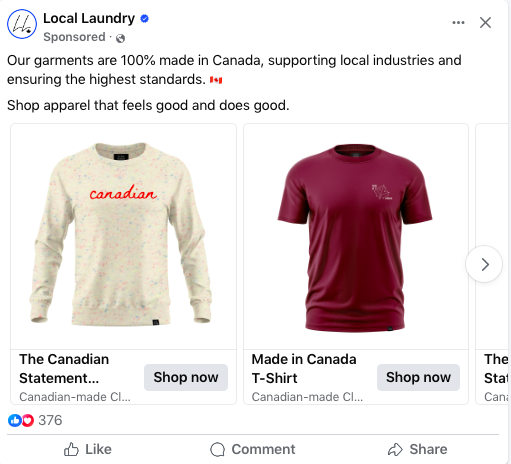
Source: Local Laundry
5 Quick ways to start today
As you’ve seen, there are plenty of options for creating, testing, and succeeding with carousel ads. Feeling overwhelmed? Here are five simple ideas to create your first carousel ad before you leave work today:
- Boost an organic carousel that this already performing well.
- Check your analytics to find a longer text post or a video post (paid or organic) that’s performing well and break the content up into three cards.
- Pull the top five stats from a recent whitepaper or report your brand created and make a card for each. These could be infographics, or they could just be text with a simple design treatment.
- Upload your product catalog and create a dynamic catalog carousel ad in a few clicks.
- Head to Hootsuite’s free content ideas generator, enter your relevant nouns and primary keyword, and choose infographic as your content type. This will give you some good ideas with graphic and text suggestions that can easily be used as the framework for a carousel post. (Tip: Use the Canva integration in Hootsuite or our free Canva templates to build the relevant carousel cards.)
Get more from your ad budget by managing paid and organic content in one powerful dashboard. Easily launch, track, optimize, and report on every campaign with Hootsuite.






